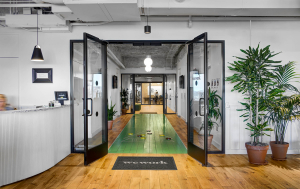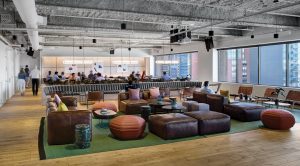THE FLEX FACTOR Coworking and the Flexible Office Market
The coworking/flexible office model has undoubtedly disrupted the traditional corporate real estate market. Since WeWork brought the concept to the big stage a few years ago, flexible office leasing has become a sizeable percentage of the office market—and it’s growing. In fact, JLL predicts that nearly 30% of US office space could be consumed flexibly by 2030.

HOW DID WE GET HERE?
The seemingly sudden popularity of “flex” space comes down to employee demand, says Brian Harrington, chief experience officer at Hana, CBRE’s flexible space solution.
“There’s an arms race for talent, and the talent is demanding new workplace solutions that better fit their needs,” he says. “Those can range from food and beverage options to different ways and places to work in the space.”
As that demand has grown, investment has followed. Scott Homa, director of US office research for JLL, says that a confluence of factors has contributed to the market’s meteoric rise.
“We’ve seen so much private equity and venture capital money fueling the growth in this sector,” he says. “With the demand, the value proposition for tenants resonates even more because of the speed, convenience and flexibility the short-term commitment offers.”
THE OWNER CONNECTION
While user demand may have driven the trend, owners are now reshaping it. As the coworking and flexible market took hold, CBRE was getting questions from clients about flexible offerings and hearing feedback from owners who wanted to be more involved in the process.
“Landlords began saying they wanted a flexible space solution set that provides them a little more control over their space than what was being offered in the market,” says Harrington. “They were looking for more involvement in and transparency about what types of clients were in their buildings.”
That’s where CBRE’s Hana offering comes in. Hana—which means “work,” “happiness,” and “flower” in different languages—allows CBRE to leverage their long-term relationships with building owners to offer clients flexible options across their entire portfolio.
“We’re bridging the gap between owners and occupiers,” Harrington says. “We’re giving occupiers the space they desire with the flexibility of a short-term lease, and we’re giving owners transparency and a deal structure that is more of a partnership.”

DREAM TEAM
So what does a flexible office model mean for workplace design and construction? At WeWork and other coworking operators, some design and construction functions have been taken in-house to achieve the scale they are working toward. At Hana, they still rely on design and construction partners but selectively choose those who understand the specific needs of the flex market:
1. Speed and flexibility. “Our partners need to be able to act fast and be flexible,” says Harrington
2.Brand education. Hana offers a particular experience for tenants, and their project partners must fully understand that value proposition. As Harrington puts it, they “sweat the details” at Hana and need partners who execute with the same approach. Abundant access to power outlets, for example, is a focus in every Hana space.
3. Scalability. “The ability to improve on the process and create a replicable model is also key”, says Harrington. “We want partners like STO who can help us get better at what we do,” he says. “That give and take is critically important.”
FLEXING THE FUTURE
As JLL’s research shows, the flex office market isn’t going anywhere as owners and tenants alike become more educated and savvy
about their options.
“Year to date, we’ve seen a 15% acceleration in coworking supply relative to last year,” says Homa. “We think there is going to be a continued shift of demand and evolution in real estate that favors more flexible consumption”.
Hana’s Harrington agrees. “I don’t think long-term leases will go away,” he says. “But flex space provides a very interesting option for certain types of occupiers and a certain percentage of their portfolio to make a meaningful difference to their end users.”
